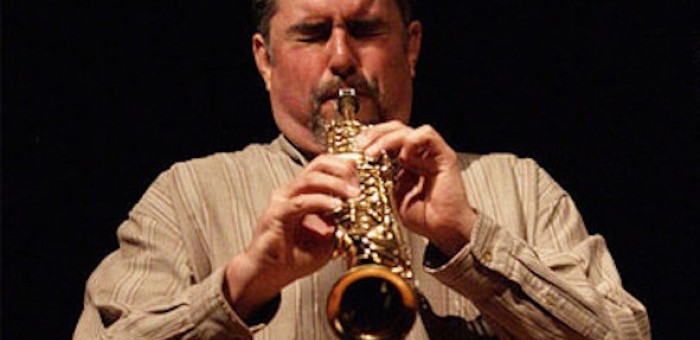Oct 28, 2025 10:47 AM
In Memoriam: Jack DeJohnette, 1942–2025
Jack DeJohnette, a bold and resourceful drummer and NEA Jazz Master who forged a unique vocabulary on the kit over his…

Tony Malaby (seen here in a press photo) performed with three ensembles at Elastic Arts in Chicago on March 24–25.
(Photo: Claudio Casanova)There was a time in jazz when all roads led to New York. Tenor and soprano saxophonist Tony Malaby took that road when he left his home state of Arizona in 1995.
Since then, he’s been a versatile and robust contributor to the city’s jazz scene, with a CV that includes an early stint with the Mingus Big Band and recent work with Fred Hersch, as well as leading or co-leading several strikingly different bands. There’s the lyrical and hard-swinging Paloma Recia with guitarist Ben Monder, bassist Eivind Opsvik, and drummer Nasheet Waits; Tubacello, a quartet with tubist Dan Peck, cellist Christopher Hoffman and drummer John Hollenbeck, that thrives on the textural contrasts of its titular instruments; and Tamarindo, a free-flowing trio with Waits and bassist William Parker.
But as busy as Malaby is in New York, he’s also made it a point to work for extended periods with musicians in other locales, such as the 10-day residency he spent in Bogotá, Colombia, in 2013. So he was a natural first choice when Chicago’s Elastic Arts, a non-profit space on the city’s north side, decided to begin hosting musicians for extended sojourns.
Malaby had already played with Chicago-based musicians, most notably on the CD Warblepeck (Songlines) with cellist Fred Lonberg-Holm. On March 23, Malaby commenced two days of improvisation workshops for young musicians at Elastic Arts, and also began rehearsing with the nine established locals who would accompany him for a performance there on March 24–25.
Malaby performed with three different groups during his residency, appearing on opening night with two small groups, each of which showcased a different side of his improvisational acumen. First, Malaby joined Lonberg-Holm and percussionist Michael Zerang for a set of suspenseful, no-holds-barred free improvisation.
The cellist, who currently uses electronics to transform the voice of his instrument, and the percussionist have been playing together as a duo and with musicians like John Butcher and Joe McPhee for over 20 years, so part of Malaby’s challenge was to find a way into a well-established dialogue. He did so by proposing contrasts in tone, timbre and content, culminating in an extraordinary passage where he and Lonberg-Holm simultaneously sustained dueling lines.
There was music on the stands for the second March 24 set, in which pianist Paul Giallorenzo, bassist Jason Roebke, and drummer Charles Rumback played Malaby’s compositions. This set proposed two additional elements of the saxophonist’s music—an approach to rhythm that uses swing as an opening gambit ripe for deconstruction, and a close attention to dynamics of density and volume.
On March 25, Malaby led nine local musicians (Dave Rempis, alto saxophone; Jason Stein, bass clarinet; Tim Daisy, drums; Josh Berman, cornet; Jason Adasiewicz, vibraphone; and Giallorenzo, Roebke, Rumback and Lonberg-Holm) through arrangments by pianist Kris Davis. The presence of mallets and extra percussion gave the Chicago ensemble a fuller, less brassy sound than can be heard on the recording Novela (Clean Feed).
Despite having just two days of rehearsal, the players were well attuned to the music’s requirements; Malaby did not have to stand up and guide them, but did most of his conducting with small glances delivered while he played his horns.
The Davis/Malaby book does not treat the ensemble as either a “big small group” or a “little big band,” but as a phenomenon unto itself, one that is capable of both great flexibility and considerable complexity. The Chicagoans heeded Malaby’s command to attend to dynamics, which enabled the music to move fluidly between stark exposition and careful articulation of layered textures. Even Malaby’s own solos were expressions of the music’s total logic.
While solos and duets afforded the players opportunities to display their individual voices, they also required them to be mindful contributors to the balance of a large and living group sound. While the music’s bold and sometimes clashing sonorities can be characterized as free-jazz, this was in fact music of great specificity. It also expressed considerable emotional range, by turns tender on “Mother’s Love” and quite playful on “Warblepeck.” DB

Jack DeJohnette boasted a musical resume that was as long as it was fearsome.
Oct 28, 2025 10:47 AM
Jack DeJohnette, a bold and resourceful drummer and NEA Jazz Master who forged a unique vocabulary on the kit over his…

D’Angelo achieved commercial and critical success experimenting with a fusion of jazz, funk, soul, R&B and hip-hop.
Oct 14, 2025 1:47 PM
D’Angelo, a Grammy-winning R&B and neo-soul singer, guitarist and pianist who exerted a profound influence on 21st…

To see the complete list of nominations for the 2026 Grammy Awards, go to grammy.com.
Nov 11, 2025 12:35 PM
The nominations for the 2026 Grammy Awards are in, with plenty to smile about for the worlds of jazz, blues and beyond.…

Flea has returned to his first instrument — the trumpet — and assembled a dream band of jazz musicians to record a new album.
Dec 2, 2025 2:01 AM
After a nearly five-decade career as one of his generation’s defining rock bassists, Flea has returned to his first…

Drummond was cherished by generations of mainstream jazz listeners and bandleaders for his authoritative tonal presence, a defining quality of his style most apparent when he played his instrument unamplified.
Nov 4, 2025 11:39 AM
Ray Drummond, a first-call bassist who appeared on hundreds of albums as a sideman for some of the top names in jazz…





